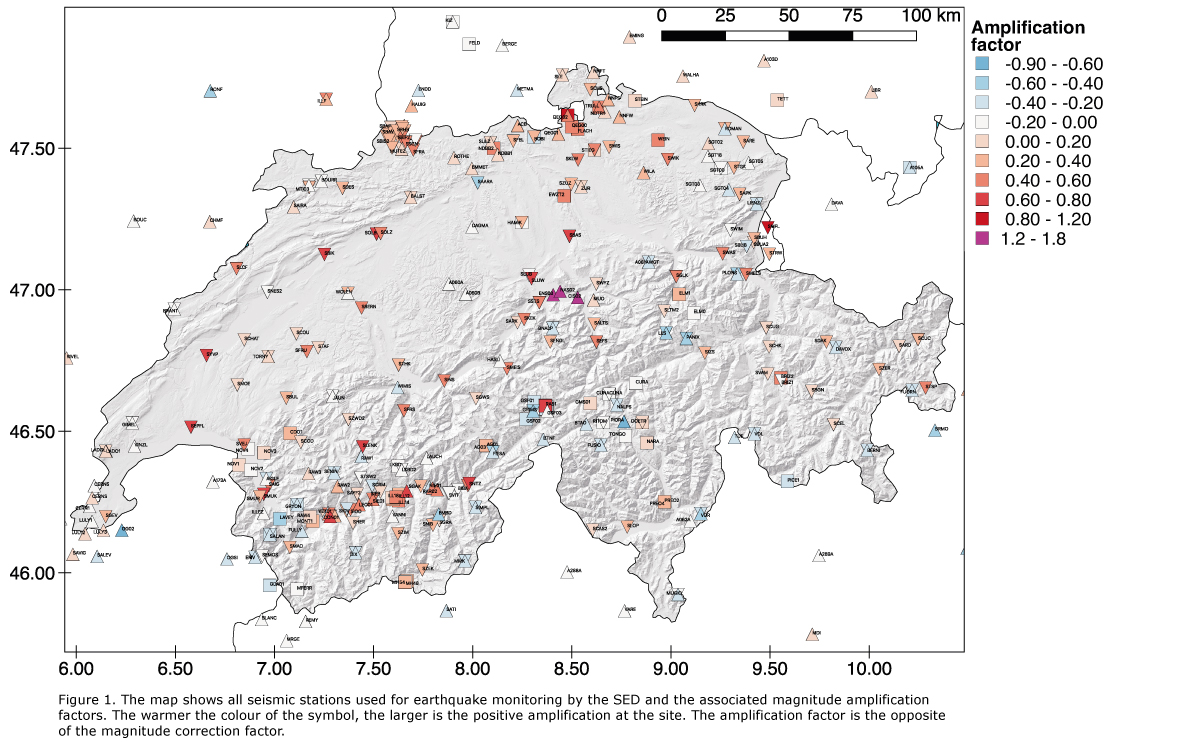2021-03-19
MLhc: a revised local magnitude for Switzerland
One of the most common ways to characterise an earthquake is by its magnitude, which quantifies the energy released during an earthquake, i.e. its strength. The larger the earthquake's magnitude, the more likely it becomes to feel the shaking. There are different types of magnitudes: for example, the local magnitude (ML, the Richter scale, for earthquakes recorded close-by), the body wave magnitude (mb, for earthquakes at large distances), the surface wave magnitude (MS, also for large distances) or the moment magnitude (Mw, for all earthquakes types). These different scales have been developed and modified over the last century, reflecting mainly our improving capability to monitor earthquakes of different sizes and at different distances. Common to all magnitude types is the fact that they can be calculated directly from the earthquake signals recorded by seismic stations. In order to better characterise earthquakes in Switzerland, the Swiss Seismological Service at the ETH Zurich (SED) has recently introduced a revised local magnitude (MLhc).
Read more...MLhc makes the routine computation of local magnitudes in Switzerland entirely consistent with the state-of-the-art of engineering seismology research at the SED, and allows optimal use of the high-density Swiss National Seismic Network. What does this mean exactly, and how does MLhc differ from the previous local magnitude we used?
Earthquakes are commonly characterised using the local magnitude (ML), originally introduced by Charles Richter in California in 1935. ML is often found to be region dependent. In 1984, Urs Kradolfer, a former scientist at SED, calibrated ML for Swiss earthquakes. His calculations were based on the recordings of the Swiss National Seismic Network, which comprised 23 stations at that time that recorded vertical ground motions only. At the turn of the century, Kradolfer’s model was later amended to take advantage of the next generation of 3-component digital broadband instruments in the upgraded Swiss National Seismic, in particular by using horizontal ground motion records (MLh).
In the last 20 years, the Swiss National Seismic network has grown significantly and now comprises more than 200 seismic stations, including over 100 high-quality strong-motion sensors. The SED is now routinely recording earthquakes at very close distances (15 to 20 km) to their focus in the ground (hypocenter), often with MLh much smaller than 2. Such close distances and small magnitudes are outside the calibration range of Kradolfer’s model. Another limitation of MLh is that station correction factors due to local soil conditions were not systematically used. However, this is crucial, particularly at strong-motion sites mostly installed in urban areas and often characterised by significant amplification of ground motions. When using MLh, seismologists had to reject station magnitudes from sites too close to the earthquake or with strong site amplifications. To cope with these drawbacks, the SED recently migrated to a revised local magnitude: "MLhc". The “c” stands for "corrected".
In summary, by design MLhc has been calibrated to provide magnitudes that are as similar as possible to MLh, yet with two considerable improvements that allow seismologists to use all stations collected in the network and provide more stable magnitudes, especially for small earthquakes:
- First, it is calibrated using a much larger dataset including many records from very close to the hypocentre. Therefore, MLhc allows us to include stations at distances closer than 20 km from the hypocenter.
- Second, the procedure to compute MLhc accounts for physics-based site amplification factors that are routinely calculated and updated by the SED, allowing us to use all stations regardless of site effects.
While for a simpler communication, the SED only uses the term "magnitude", the detailed information provided on the SED website always specify the earthquake magnitude type.
More information on the different magnitude types can be found here.
